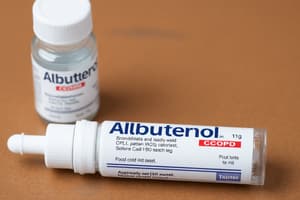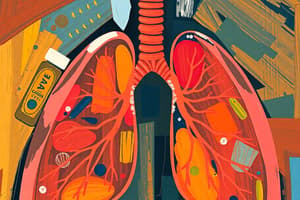Podcast
Questions and Answers
A patient with COPD is prescribed a bronchodilator that inhibits acetylcholine receptors. Which class of medication is the patient most likely taking?
A patient with COPD is prescribed a bronchodilator that inhibits acetylcholine receptors. Which class of medication is the patient most likely taking?
- Inhaled Corticosteroids
- Anticholinergics (correct)
- Methylxanthines
- Beta-agonists
Which of the following is a key difference between short-acting beta-agonists (SABAs) and long-acting beta-agonists (LABAs)?
Which of the following is a key difference between short-acting beta-agonists (SABAs) and long-acting beta-agonists (LABAs)?
- SABAs provide quick relief during acute bronchospasm, while LABAs offer sustained bronchodilation. (correct)
- SABAs are administered orally, while LABAs are inhaled.
- SABAs stimulate muscarinic receptors, while LABAs stimulate beta-adrenergic receptors.
- SABAs are used for long-term control, while LABAs are used for acute exacerbations.
Why is it important to monitor drug levels when a patient is taking methylxanthines?
Why is it important to monitor drug levels when a patient is taking methylxanthines?
- To assess the patient's adherence to the prescribed regimen.
- To avoid toxicity due to the narrow therapeutic index. (correct)
- To prevent the medication from interacting with other drugs.
- To ensure the medication is effectively reducing inflammation.
A patient using an inhaled corticosteroid (ICS) develops oral thrush. What measure can the patient take to help prevent this side effect?
A patient using an inhaled corticosteroid (ICS) develops oral thrush. What measure can the patient take to help prevent this side effect?
What is the primary benefit of using combination inhalers in the treatment of respiratory conditions?
What is the primary benefit of using combination inhalers in the treatment of respiratory conditions?
Which of the following best describes the mechanism of action of leukotriene modifiers in managing asthma?
Which of the following best describes the mechanism of action of leukotriene modifiers in managing asthma?
What is the primary use of mast cell stabilizers in the treatment of respiratory conditions?
What is the primary use of mast cell stabilizers in the treatment of respiratory conditions?
Which of the following is the most appropriate use of antitussives?
Which of the following is the most appropriate use of antitussives?
A patient with hypoxemia requires oxygen therapy to improve blood oxygen levels. Which of the following is a method of oxygen delivery that can provide ventilatory support without intubation?
A patient with hypoxemia requires oxygen therapy to improve blood oxygen levels. Which of the following is a method of oxygen delivery that can provide ventilatory support without intubation?
In which patient population are pulmonary surfactants primarily used?
In which patient population are pulmonary surfactants primarily used?
What is the mechanism of action of Omalizumab in treating severe asthma?
What is the mechanism of action of Omalizumab in treating severe asthma?
Which delivery device requires coordination between actuation and inhalation for effective drug delivery?
Which delivery device requires coordination between actuation and inhalation for effective drug delivery?
A patient with cystic fibrosis is prescribed dornase alfa. How does this medication improve lung function?
A patient with cystic fibrosis is prescribed dornase alfa. How does this medication improve lung function?
What is the role of expectorants in treating respiratory conditions?
What is the role of expectorants in treating respiratory conditions?
A patient is prescribed acetylcysteine. Besides its use as a mucolytic, for what additional purpose can it be used?
A patient is prescribed acetylcysteine. Besides its use as a mucolytic, for what additional purpose can it be used?
Which of the following is a primary consideration when using dry powder inhalers (DPIs)?
Which of the following is a primary consideration when using dry powder inhalers (DPIs)?
A patient is using a metered-dose inhaler (MDI) without a spacer. What potential issue might this cause?
A patient is using a metered-dose inhaler (MDI) without a spacer. What potential issue might this cause?
When should regular monitoring of respiratory function be conducted in patients using respiratory medications?
When should regular monitoring of respiratory function be conducted in patients using respiratory medications?
Which of the following pulmonary function tests (PFTs) is most commonly used to measure lung volumes and airflow rates?
Which of the following pulmonary function tests (PFTs) is most commonly used to measure lung volumes and airflow rates?
What should patient education primarily focus on regarding respiratory medication use?
What should patient education primarily focus on regarding respiratory medication use?
Flashcards
Bronchodilators
Bronchodilators
Relax smooth muscles around airways, easing breathing in conditions like asthma and COPD.
Beta-Agonists
Beta-Agonists
Stimulate beta-adrenergic receptors in lungs, leading to bronchodilation; can be short or long-acting.
Anticholinergics
Anticholinergics
Block acetylcholine receptors, reducing bronchoconstriction and mucus production.
Methylxanthines
Methylxanthines
Signup and view all the flashcards
Inhaled Corticosteroids (ICS)
Inhaled Corticosteroids (ICS)
Signup and view all the flashcards
Combination Inhalers
Combination Inhalers
Signup and view all the flashcards
Leukotriene Modifiers
Leukotriene Modifiers
Signup and view all the flashcards
Mast Cell Stabilizers
Mast Cell Stabilizers
Signup and view all the flashcards
Expectorants
Expectorants
Signup and view all the flashcards
Mucolytics
Mucolytics
Signup and view all the flashcards
Antitussives
Antitussives
Signup and view all the flashcards
Oxygen Therapy
Oxygen Therapy
Signup and view all the flashcards
Pulmonary Surfactants
Pulmonary Surfactants
Signup and view all the flashcards
Immunomodulators
Immunomodulators
Signup and view all the flashcards
Metered-Dose Inhalers (MDIs)
Metered-Dose Inhalers (MDIs)
Signup and view all the flashcards
Dry Powder Inhaler (DPI)
Dry Powder Inhaler (DPI)
Signup and view all the flashcards
Nebulizers
Nebulizers
Signup and view all the flashcards
Antihistamines
Antihistamines
Signup and view all the flashcards
Decongestants
Decongestants
Signup and view all the flashcards
Analgesics
Analgesics
Signup and view all the flashcards
Study Notes
- Respiratory medications encompass a wide range of drugs used to treat various respiratory conditions
- These medications aim to improve airflow, reduce inflammation, manage symptoms, and prevent complications
Bronchodilators
- Bronchodilators relax the smooth muscles surrounding the airways, widening them and easing breathing
- They are commonly used in conditions like asthma and chronic obstructive pulmonary disease (COPD)
Beta-Agonists
- Beta-agonists stimulate beta-adrenergic receptors in the lungs, leading to bronchodilation
- Short-acting beta-agonists (SABAs): Provide quick relief during acute bronchospasm
- Examples: albuterol, levalbuterol
- Administered via inhalers or nebulizers for rapid onset
- Long-acting beta-agonists (LABAs): Offer sustained bronchodilation for long-term control
- Examples: salmeterol, formoterol
- Typically used in combination with inhaled corticosteroids due to potential risks when used alone
Anticholinergics
- Anticholinergics block acetylcholine receptors in the airways, reducing bronchoconstriction and mucus production
- Short-acting anticholinergics: Provide relief during acute exacerbations
- Example: ipratropium bromide
- Often combined with SABAs for enhanced bronchodilation
- Long-acting anticholinergics (LAMAs): Offer prolonged bronchodilation for maintenance therapy
- Examples: tiotropium, umeclidinium
- Provides sustained relief in COPD management
Methylxanthines
- Methylxanthines, such as theophylline, are bronchodilators with anti-inflammatory properties
- Mechanism of action involves phosphodiesterase inhibition and adenosine receptor antagonism
- Narrow therapeutic index requires careful monitoring of drug levels to avoid toxicity
- Use has declined due to the availability of safer and more effective alternatives
Inhaled Corticosteroids (ICS)
- Inhaled corticosteroids reduce inflammation in the airways, decreasing swelling and mucus production
- Commonly used for long-term control of asthma and COPD
- Examples: budesonide, fluticasone, beclomethasone
- Administered via inhalers or nebulizers for direct delivery to the lungs
- Long-term use can lead to side effects such as oral thrush and hoarseness; rinsing the mouth after inhalation can help prevent these
Combination Inhalers
- Combination inhalers contain two or more medications in a single device, improving convenience and adherence
- Common combinations include:
- ICS/LABA: Combines an inhaled corticosteroid with a long-acting beta-agonist
- Examples: fluticasone/salmeterol, budesonide/formoterol
- Used for long-term control of asthma and COPD
- LAMA/LABA: Combines a long-acting muscarinic antagonist with a long-acting beta-agonist
- Examples: umeclidinium/vilanterol, tiotropium/olodaterol
- Used for COPD management
- ICS/LAMA/LABA: Combines an inhaled corticosteroid, a long-acting muscarinic antagonist, and a long-acting beta-agonist
- Example: budesonide/glycopyrrolate/formoterol
- Used for COPD management
- ICS/LABA: Combines an inhaled corticosteroid with a long-acting beta-agonist
Leukotriene Modifiers
- Leukotriene modifiers block the action of leukotrienes, inflammatory mediators that contribute to airway constriction and mucus production
- Used for long-term control of asthma, particularly in patients with allergic or exercise-induced asthma
- Examples: montelukast, zafirlukast
- Administered orally
Mast Cell Stabilizers
- Mast cell stabilizers prevent the release of inflammatory substances from mast cells, reducing airway inflammation and hyperreactivity
- Used for prophylactic treatment of asthma, particularly in children and patients with exercise-induced asthma
- Example: cromolyn sodium
- Administered via inhaler or nebulizer
Expectorants and Mucolytics
- Expectorants help to loosen and thin mucus in the airways, making it easier to cough up
- Example: guaifenesin
- Available over-the-counter
- Mucolytics break down the chemical bonds in mucus, reducing its viscosity and promoting expectoration
- Examples: acetylcysteine, dornase alfa
- Acetylcysteine is administered via nebulizer and can also be used to protect the kidneys during the administration of radiographic contrast dye, and to treat paracetamol overdose
- Dornase alfa is used in cystic fibrosis to break down DNA in mucus and improve lung function
Antitussives
- Antitussives suppress the cough reflex, providing relief from coughing
- Used for symptomatic treatment of dry, nonproductive coughs
- Examples:
- Opioids: codeine, hydrocodone (act centrally to suppress cough)
- Non-opioids: dextromethorphan (acts centrally), benzonatate (acts peripherally)
- Use is generally discouraged in productive coughs, as it can impair airway clearance
Oxygen Therapy
- Oxygen therapy provides supplemental oxygen to patients with hypoxemia (low blood oxygen levels)
- Administered via nasal cannula, face mask, or mechanical ventilation
- Used to improve oxygen saturation and reduce the workload on the heart and lungs
- Different delivery methods include:
- Nasal Cannula: Delivers low-flow oxygen
- Face Mask: Delivers higher concentrations of oxygen
- Non-Invasive Ventilation (NIV): Provides ventilatory support without intubation
- Mechanical Ventilation: Provides ventilatory support via an endotracheal tube or tracheostomy
Pulmonary Surfactants
- Pulmonary surfactants reduce surface tension in the alveoli, preventing alveolar collapse and improving lung compliance
- Used in premature infants with respiratory distress syndrome (RDS) to improve lung function
- Examples: beractant, calfactant
- Administered via endotracheal tube
Immunomodulators
- Immunomodulators modify the immune response to reduce inflammation and prevent exacerbations
- Used in severe asthma and other respiratory conditions
- Examples:
- Omalizumab: Anti-IgE antibody that reduces allergic inflammation
- Biologic therapies: Target specific inflammatory pathways in asthma
Considerations
- Delivery devices significantly impact drug delivery to the lungs
- Common devices include metered-dose inhalers (MDIs), dry powder inhalers (DPIs), and nebulizers
- MDIs require coordination between actuation and inhalation; spacers can improve drug delivery
- DPIs are breath-activated and require sufficient inspiratory flow
- Nebulizers convert liquid medication into a fine mist for inhalation, suitable for patients who cannot use MDIs or DPIs
- Patient education is crucial for proper medication use and adherence
- Patients should be educated on the correct use of inhalers and other devices, as well as the importance of adherence to prescribed regimens
- Regular monitoring of respiratory function is important to assess treatment response and adjust therapy as needed
- Pulmonary function tests (PFTs), such as spirometry, measure lung volumes and airflow rates
- Monitoring symptoms and exacerbation frequency can help guide treatment decisions
Studying That Suits You
Use AI to generate personalized quizzes and flashcards to suit your learning preferences.




